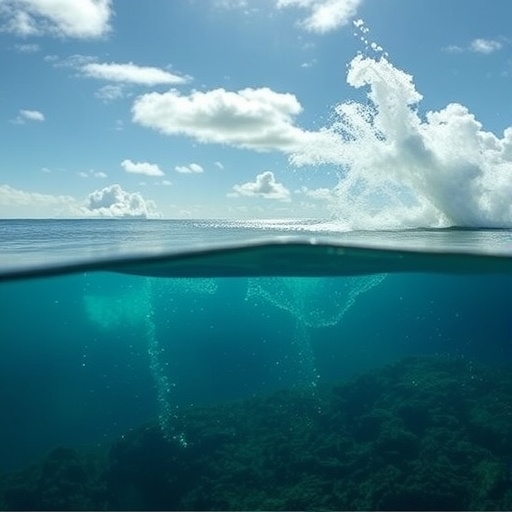In a groundbreaking study recently published in Nature Communications, scientists have revealed alarming insights into the rapid acidification of the Northeastern Pacific Ocean, a crucial marine region bordering North America. This acidification trend, accelerated by anthropogenic carbon dioxide emissions and natural oceanic processes, threatens the survival of key marine organisms and jeopardizes the prosperity of ecosystems and coastal communities dependent on these waters.
Since the dawn of the industrial revolution over two centuries ago, the world’s oceans have witnessed a disturbing 30% increase in acidity. This chemical transformation is primarily driven by the absorption of atmospheric CO2, which dissolves in seawater forming carbonic acid, subsequently releasing hydrogen ions that lower pH levels. In marine ecosystems, such shifts in ocean chemistry critically impair calcifying organisms such as corals and mollusks, which rely on carbonate ions to construct their skeletal structures. The Northeastern Pacific, however, presents an exceptional case. Its baseline acidity is elevated due to natural factors like upwelling currents, which raises questions about how this vulnerability will intensify amid future emissions.
The study’s authors, led by University of Washington oceanographers Alex Gagnon and doctoral student Mary Margaret Stoll, meticulously analyzed coral skeletons from species native to the Pacific—specifically orange cup corals, which serve as living archives of past seawater chemistry. By comparing preindustrial coral specimens collected from the late 19th to early 20th centuries with modern samples collected from identical locations, they unearthed striking evidence of accelerated acidification in California Current waters. This upwelling-driven system brings deep CO2-rich waters to the surface, amplifying acidification beyond that observed in atmospheric measurements alone.
Central to the research was the innovative use of boron isotope ratios extracted from coral skeletons, a cutting-edge proxy technique for reconstructing historical pH levels. Boron exists in seawater primarily as boric acid and borate ions, with their relative abundances shifting in response to pH. Corals incorporate borate ions as they grow; analyzing their ratio in fossilized skeletons allowed the team to chart acidification trends with unprecedented temporal depth and resolution. Their findings reveal that the rate of CO2 increase and associated acidification in subsurface waters between 100 to 200 meters depth far outpaces surface trends and atmospheric CO2 rise, illustrating an amplification effect driven by natural ocean circulation.
The study highlights the profound influence of the California Current System combined with coastal upwelling phenomena. Upwelling brings nutrient- and CO2-rich deep waters to the surface, supporting diverse ecosystems but simultaneously elevating local acidity. This dynamic creates severe challenges for marine calcifiers that depend on stable carbonate chemistry for shell and skeleton formation. The elevated acidification rates isolate the Northeastern Pacific as a frontline indicator of oceanic changes anticipated globally in coming decades under ongoing greenhouse emissions.
Beyond its ecological implications, the acidification documented poses serious socioeconomic consequences for the Salish Sea region, spanning marine habitats between Washington State and Canadian waters. This locale supports vibrant fisheries and indigenous communities with millennia-long cultural ties to marine life. The rapid degradation of calcifying organisms threatens these fisheries’ productivity and resilience, cascading through food webs and ecosystem services essential to coastal livelihoods and biodiversity.
Despite these worrying trends, the researchers express cautious optimism. The clarity of chemical evidence provided by their century-spanning study empowers more targeted policy and conservation interventions. By understanding the natural and anthropogenic drivers of acidification, mitigation strategies including emission reductions and regional ocean monitoring can be refined to protect vulnerable marine habitats. The authors emphasize that these findings represent a crucial call to action rather than inevitability, underscoring humanity’s capacity to influence ocean future trajectories.
This investigation marks a significant advancement in oceanographic sciences, addressing longstanding uncertainties surrounding past ocean chemistry variability and modern anthropogenic impacts. It leverages historic museum collections alongside contemporary field sampling, utilizing interdisciplinary techniques bridging marine biology, chemistry, and climate science. The detailed reconstruction of past acidification trends fills a critical knowledge gap, providing robust baselines against which ongoing changes can be contextualized and quantified.
Moreover, this research advances the understanding of how natural ocean processes such as upwelling interact with global carbon cycles to modulate acidification spatially and temporally. These findings suggest that other upwelling-dominated regions worldwide may experience similar amplification effects, necessitating more comprehensive global assessments. Such information is paramount for developing predictive models that inform climate adaptation and marine management policies, helping forecast ecological vulnerabilities and resilience under future climate scenarios.
In summary, the study conducted by Gagnon, Stoll, and their collaborators not only exposes the accelerating acidification in the Northeastern Pacific but also illuminates how regional oceanographic dynamics exacerbate the impacts of global carbon emissions. By shining a light on these processes through centuries of coral records, it provides an urgent narrative on the fragility of marine ecosystems in a rapidly changing world. Its interdisciplinary approach and clear implications for conservation and climate policy establish it as a critical reference point for researchers, policymakers, and advocates dedicated to ocean health.
As the authors poignantly state, the ocean is far from destroyed but requires immediate and sustained action to change its trajectory. The unique position of the Salish Sea and California Current System as sentinels of acidification provides a valuable early-warning system. Protecting these regions through emissions reductions and adaptive coastal management will be instrumental in preserving marine biodiversity and ecosystem services not only locally, but globally as acidification trends spread across the world’s oceans.
Subject of Research: Ocean acidification and its amplification by upwelling in the California Current System.
Article Title: A century of change in the California Current: upwelling system amplifies acidification
News Publication Date: 13-Nov-2025
Web References:
https://www.nature.com/articles/s41467-025-63207-6
https://www.noaa.gov/education/resource-collections/ocean-coasts/ocean-acidification
https://grist.org/oceans/the-oceans-just-hit-an-ominous-milestone/
Image Credits: Robert Evans, bobevansphotography.com
Keywords: Ocean acidification, Ocean chemistry, Ocean pH, Marine ecosystems, Coral, Marine life, Coastal zones, Upwelling, Anthropogenic climate change, Climate change effects, Carbon emissions




